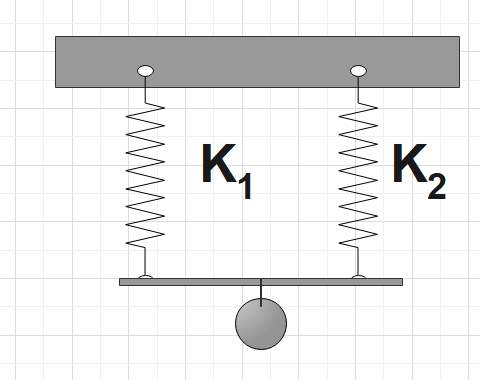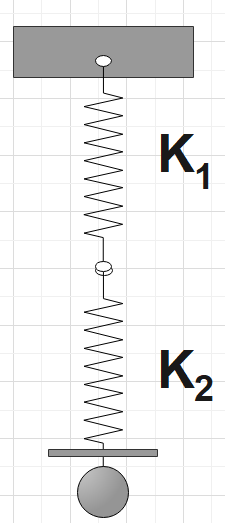
What is the spring constant in parallel connection and series connection?
Answer
501k+ views
Hint: Two massless springs that follow Hooke's Law are said to be connected in parallel when they are connected by a thin, vertical rod, as shown in the diagram below. The formula for capacitors connected in parallel in an electrical circuit can be used to find the value of k.
Complete answer:
For parallel:

Two massless springs that follow Hooke's Law are said to be connected in parallel when they are connected by a thin, vertical rod.
$k_{1}$ and $k_{2}$ are the spring constants for springs 1 and 2. The rod is subjected to a constant force $F$, which keeps it perpendicular to the force's direction. In order for the springs to be the same length. The springs could also be compressed if the force was reversed.
A single Hookean spring of spring constant $k$ is equivalent to this system of two parallel springs. The formula for parallel capacitors in an electrical circuit can be used to calculate the value of $k$.
$k=k_{1}+k_{2}$
For Series

Here the equivalent spring constant would be,
$k=\dfrac{{{k}_{1}}{{k}_{2}}}{{{k}_{1}}+{{k}_{2}}}$
When the same springs are connected in series, as shown in the diagram below, this is referred to as a series connection. On spring 2, a constant force F is applied. As a result, the springs are elongated, and the total extension of the combination equals the sum of each spring's elongation. Alternatively, the springs could be compressed by reversing the force direction.
A single spring of spring constant k is equivalent to this system of two springs in series. The formula for capacitors connected in series in an electrical circuit can be used to calculate the value of k.
Note: When two or more springs are connected end-to-end or point-to-point in mechanics, they are said to be in series, and when they are connected side-by-side, they are said to be in parallel; in both cases, they act as a single spring.
Complete answer:
For parallel:

Two massless springs that follow Hooke's Law are said to be connected in parallel when they are connected by a thin, vertical rod.
$k_{1}$ and $k_{2}$ are the spring constants for springs 1 and 2. The rod is subjected to a constant force $F$, which keeps it perpendicular to the force's direction. In order for the springs to be the same length. The springs could also be compressed if the force was reversed.
A single Hookean spring of spring constant $k$ is equivalent to this system of two parallel springs. The formula for parallel capacitors in an electrical circuit can be used to calculate the value of $k$.
$k=k_{1}+k_{2}$
For Series

Here the equivalent spring constant would be,
$k=\dfrac{{{k}_{1}}{{k}_{2}}}{{{k}_{1}}+{{k}_{2}}}$
When the same springs are connected in series, as shown in the diagram below, this is referred to as a series connection. On spring 2, a constant force F is applied. As a result, the springs are elongated, and the total extension of the combination equals the sum of each spring's elongation. Alternatively, the springs could be compressed by reversing the force direction.
A single spring of spring constant k is equivalent to this system of two springs in series. The formula for capacitors connected in series in an electrical circuit can be used to calculate the value of k.
Note: When two or more springs are connected end-to-end or point-to-point in mechanics, they are said to be in series, and when they are connected side-by-side, they are said to be in parallel; in both cases, they act as a single spring.
Recently Updated Pages
Master Class 8 Maths: Engaging Questions & Answers for Success

Class 8 Question and Answer - Your Ultimate Solutions Guide

Master Class 7 Maths: Engaging Questions & Answers for Success

Class 7 Question and Answer - Your Ultimate Solutions Guide

Master Class 6 Maths: Engaging Questions & Answers for Success

Class 6 Question and Answer - Your Ultimate Solutions Guide

Trending doubts
What is meant by exothermic and endothermic reactions class 11 chemistry CBSE

Which animal has three hearts class 11 biology CBSE

10 examples of friction in our daily life

One Metric ton is equal to kg A 10000 B 1000 C 100 class 11 physics CBSE

1 Quintal is equal to a 110 kg b 10 kg c 100kg d 1000 class 11 physics CBSE

Difference Between Prokaryotic Cells and Eukaryotic Cells




